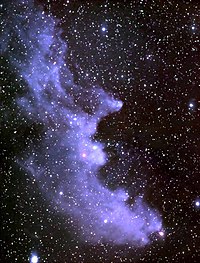astro.wikisort.org - Nebula
In astronomy, reflection nebula are clouds of interstellar dust which might reflect the light of a nearby star or stars. The energy from the nearby stars is insufficient to ionize the gas of the nebula to create an emission nebula, but is enough to give sufficient scattering to make the dust visible. Thus, the frequency spectrum shown by reflection nebulae is similar to that of the illuminating stars. Among the microscopic particles responsible for the scattering are carbon compounds (e. g. diamond dust) and compounds of other elements such as iron and nickel. The latter two are often aligned with the galactic magnetic field and cause the scattered light to be slightly polarized.[1]

Discovery
![Reflection nebula IC 2631.[2]](http://upload.wikimedia.org/wikipedia/commons/thumb/2/25/Young_star_lights_up_reflection_nebula_IC_2631.jpg/220px-Young_star_lights_up_reflection_nebula_IC_2631.jpg)

Analyzing the spectrum of the nebula associated with the star Merope in the Pleiades, Vesto Slipher concluded in 1912 that the source of its light is most likely the star itself, and that the nebula reflects light from the star (and that of the star Alcyone).[3] Calculations by Ejnar Hertzsprung in 1913 lend credence to that hypothesis.[4] Edwin Hubble further distinguished between the emission and reflection nebulae in 1922.[5]
Reflection nebulae are usually blue because the scattering is more efficient for blue light than red (this is the same scattering process that gives us blue skies and red sunsets).
Reflection nebulae and emission nebulae are often seen together and are sometimes both referred to as diffuse nebulae.
Some 500 reflection nebulae are known. A blue reflection nebula can also be seen in the same area of the sky as the Trifid Nebula. The supergiant star Antares, which is very red (spectral class M1), is surrounded by a large, red reflection nebula.
Reflection nebulae may also be the site of star formation.
Luminosity law
![Cosmic dust clouds in Messier 78.[6]](http://upload.wikimedia.org/wikipedia/commons/thumb/c/cf/Cosmic_dust_clouds_in_reflection_nebula_Messier_78.jpg/200px-Cosmic_dust_clouds_in_reflection_nebula_Messier_78.jpg)
In 1922, Edwin Hubble published the result of his investigations on bright nebulae. One part of this work is the Hubble luminosity law for reflection nebulae, which makes a relationship between the angular size (R) of the nebula and the apparent magnitude (m) of the associated star:
where k is a constant that depends on the sensitivity of the measurement.
See also
- Variable nebula
- List of reflected light sources
References
- Kaler, 1997.
- "A Star's Moment in the Spotlight". Retrieved 10 February 2016.
- Slipher, Vesto M. (1922). "On the spectrum of the nebula in the Pleiades". Lowell Observatory Bulletin. 2: 26–27. Bibcode:1912LowOB...2...26S.
- Hertzsprung, E. (1913). "Über die Helligkeit der Plejadennebel". Astronomische Nachrichten. 195 (23): 449–452. Bibcode:1913AN....195..449H. doi:10.1002/asna.19131952302.
- Hubble, E. P. (1922). "The source of luminosity in galactic nebulae". Astrophysical Journal. 56: 400. Bibcode:1922ApJ....56..400H. doi:10.1086/142713.
- "Sifting through Dust near Orion's Belt". ESO Press Release. Retrieved 2 May 2012.
Bibliography
- James B. Kaler (1997). Cosmic Clouds -- Birth, Death, and Recycling in the Galaxy, Scientific American Library, Freeman, New York, 1997.
На других языках
[de] Reflexionsnebel
Als Reflexionsnebel bezeichnet man in der Astronomie Wolken (Nebel) interstellaren Staubs, die das Licht benachbarter Sterne „reflektieren“, genau genommen jedoch streuen.- [en] Reflection nebula
[es] Nebulosa de reflexión
Una nebulosa de reflexión es una nube de polvo que refleja la luz procedente de una o más estrellas cercanas. La energía de estrellas cercanas es insuficiente para ionizar el gas que le conforma y así transformarse en una nebulosa de emisión, pero suficiente para permitir la necesaria dispersión de la luz que le haga visible. Como es luz reflejada, el espectro de la nebulosa es similar al de las estrellas iluminantes. A menudo las nebulosas de reflexión y las de emisión aparecen juntas; un ejemplo clásico es M42 en Orión. Entre las partículas microscópicas responsables de la dispersión están los compuestos de carbono (por ejemplo, polvo de diamante) y compuestos de otros elementos como el hierro y el níquel. Los dos últimos a menudo están alineados con el campo magnético galáctico y hacen que la luz dispersada esté ligeramente polarizada. [1][ru] Отражательная туманность
Отражательная туманность — туманность (газово-пылевое облако), подсвечиваемая звездой. Если звезда (звёзды) находится в межзвёздном облаке или рядом с ним, но недостаточно горяча (горячи), чтобы ионизовать вокруг себя значительное количество межзвёздного водорода, то основным источником оптического излучения туманности оказывается свет звёзд, рассеиваемый межзвёздной пылью.Другой контент может иметь иную лицензию. Перед использованием материалов сайта WikiSort.org внимательно изучите правила лицензирования конкретных элементов наполнения сайта.
WikiSort.org - проект по пересортировке и дополнению контента Википедии